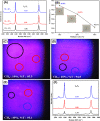A chemiresistive biosensor for detection of cancer biomarker in biological fluids using CVD-grown bilayer graphene
- PMID: 36068328
- PMCID: PMC9449275
- DOI: 10.1007/s00604-022-05463-7
A chemiresistive biosensor for detection of cancer biomarker in biological fluids using CVD-grown bilayer graphene
Abstract
A chemiresistive biosensor is described for simple and selective detection of miRNA-21. We developed chemical vapor deposition (CVD) and low-damage plasma treatment (LDPT)-treated bilayer graphene composite of graphene oxide/graphene (GO/GR) for the determination of a reliable biomarker. We have successfully overcome the self-limiting growth mechanism by using CVD method to grow more than one layer of graphene on copper foil. In addition, LDPT can be used to form GO/GR structures for chemiresistive biosensor applications. Due to the direct formation of BLGR (bilayer graphene), the coupling between graphene layers is theoretically superior to that of stacked BLGR, which is also confirmed by the blue shift of the characteristic peak of graphene in Raman spectroscopy. The shift is about double compared with that of stacked BLGR. Based on the results, the limit of detection for the target miRNA-21 was calculated to be 5.20 fM and detection rage is calculated as 100 fM to 10 nM, which is obviously better performance. Compared with previous work, this chemiresistive biosensor has good selectivity, and stability towards detection of miRNA-21. The ability to detect miRNA-21 in different biological fluids was almost identical to that in pH 7.4 phosphate-buffered saline (PBS). Thus, the proposed bilayer GO/GR of modified chemiresistive biosensor may potentially be applied to detect cancer cells in clinical examinations.
Keywords: Bilayer graphene nanocomposite; Chemical vapor deposition; Chemiresistive biosensors; Detection of cancer cells; miRNA-21 determination.
© 2022. The Author(s), under exclusive licence to Springer-Verlag GmbH Austria, part of Springer Nature.
Conflict of interest statement
The authors declare no competing interests.
Figures






References
-
- Bray F, Ferlay J, Soerjomataram I, Siegel RL, Torre LA, Jemal A. Global cancer statistics 2018: GLOBOCAN estimates of incidence and mortality worldwide for 36 cancers in 185 countries. CA: a Cancer J Clin. 2018;68:394–424. - PubMed
-
- Warner E, Plewes D, Shumak R, Catzavelos G, Di Prospero L, Yaffe M, Goel V, Ramsay E, Chart P, Cole D. Comparison of breast magnetic resonance imaging, mammography, and ultrasound for surveillance of women at high risk for hereditary breast cancer. J Clin Oncol. 2001;19:3524–3531. doi: 10.1200/JCO.2001.19.15.3524. - DOI - PubMed
-
- Gutiérrez-Gálvez L, García-Mendiola T, Gutiérrez-Sánchez C, Guerrero-Esteban T, García-Diego C, Buendía I, García-Bermejo ML, Pariente F, Lorenzo E. Carbon nanodot–based electrogenerated chemiluminescence biosensor for miRNA-21 detection. Microchim Acta. 2021;188:1–12. doi: 10.1007/s00604-021-05038-y. - DOI - PMC - PubMed
-
- Xiao Q, Li J, Jin X, Liu Y, Huang S. Ultrasensitive electrochemical microRNA-21 biosensor coupling with carboxylate-reduced graphene oxide-based signal-enhancing and duplex-specific nuclease-assisted target recycling. Sens Actuators B: Chem. 2019;297:126740. doi: 10.1016/j.snb.2019.126740. - DOI
Publication types
MeSH terms
Substances
Grants and funding
LinkOut - more resources
Full Text Sources
Other Literature Sources
Medical
